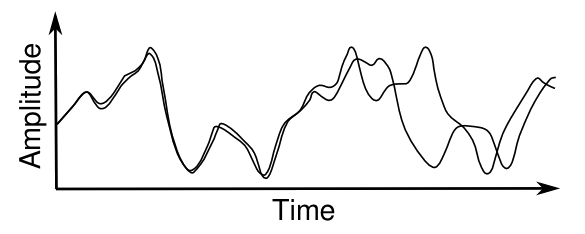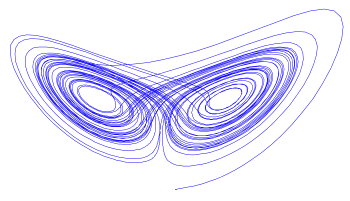Fifty Years of Chaos
September 9, 2013
If you think that the last fifty years have been more chaotic than others, you're right. This year is the fiftieth anniversary of the discovery of
chaos as a
scientifically accessible
phenomenon.[1-2] As befitting the subject matter, this discovery was
accidental.
First, a note on the name. Much of the terminology in the
physical sciences comes from the
Greek lexicon, primarily because our
science descends from the
Greek philosophical tradition. We have, for example, the word,
atom, the combination of two Greek words meaning not able to be cut. There are also the many
particles (
electron,
proton,
meson, etc.) with an
-on ending. These names are derived from Greek nouns ending in this
neuter singular ending; for example, kerion (κηριον),
honeycomb.
In
Greek mythology,
Chaos (Χαος) was the
primordial deity from whom all other
gods were born. Our modern sensibility thinks that the
void is the most pristine state of the
universe, but the
ancient Greeks thought that even the void needed a progenitor, and that was Chaos. Chaos was the progenitor of two aspects of the void. There was
Erebus (Ερεβος), "darkness," and
Nyx
(Νυξ), "night." The
Roman poet,
Ovid, characterized Chaos as "a raw and undigested mass..." ("rudis indigestaque moles...").

Chaos in Hesiod's Theogony, excerpt from lines 116-123, scanned from author's copy of ref. 3. The translation is "Verily, at the first, Chaos came to be... From Chaos came forth Erebus and black Night..."[3)]
Chaos, in its scientific sense, was discovered by the
American mathematician and
meteorologist,
Edward Norton Lorenz (1917-2008). In another example that "
chance favors the prepared mind," Lorenz made his discovery in the normal course of his research at
MIT in
computer simulations of
Earth's atmosphere. This was at the very early days of
computing, so his
computer, a
Librascope LGP-30 vacuum tube computer, had a clock rate of 120
kHz and a 4096
word drum memory of
31-bit words.
As any
scientist would do, Lorenz was careful to
document the system state for his simulations at various times so they could be
reproduced. He wrote the
variables to
three decimal places, but when he tried to reproduce his simulations, the new data didn't match the old. Lorenz initially suspected a bad vacuum tube (his computer had more than a hundred), but his investigations showed that there was no sudden error; instead, the data slowly diverged from the initial state, and they were quite different two months into his virtual
weather forecasts (see figure).

Reconstruction of Edward Lorenz' discovery plot of chaos. (Adapted from image in ref. 2.[2]
Lorenz studied this phenomenon, eventually publishing his results.[4] In his publication, he presented a simple set of
differential equations that demonstrated this effect, now called the
Lorenz attractor. An artistic
animation of the Lorenz attractor can be seen on
YouTube.[5] The computationally-minded among my readers can reproduce the attractor with the following differential equations, using
σ = 10,
ρ = 28, and
β = (8/3), iterating with a time
t increment of 0.01. The YouTube simulation used the Euler method of numerical integration.[5]
dx/dt = σ (y - x)
dy/dt = x (ρ - z) - y
dz/dt = xy - β z

An example of a Lorenz attractor.
This attractor looks more like a butterfly than the solution given using the constants, above.
(Modified Wikimedia Commons image.)
Lorenz called his phenomenon the "
butterfly effect," alluding to the idea that the flap of a butterfly's wings could change future weather. The
abstract of his first paper on the matter seemed to warn that any sort of long-term weather prediction was, in principle, impossible.[4]
"For those systems with bounded solutions, it is found that nonperiodic solutions are ordinarily unstable with respect to small modifications, so that slightly differing initial states can evolve into considerably different states... The feasibility of very-long-range weather prediction is examined in the light of these results."
Just as atoms were discussed quite some time before their being accepted as fact, so was the idea that some
dynamical systems are extremely sensitive to their initial condition. Mathematician,
Henri Poincaré, thought about this in the 1880s when he was investigating the famous
three-body problem of whether three bodies under
gravitational attraction to each other could maintain stable
orbits.[6]
Poincaré, however, didn't have a computer, and he preferred equations over numbers. That's why we're celebrating fifty years of chaos, and not 114 years.
References:
- Adilson E. Motter and David K. Campbell, "Chaos at fifty," Physics Today, vol. 66, no. 5 (May, 2013), pp. 27-33.
- Adilson E. Motter and David K. Campbell, "Chaos at fifty," arXiv Preprint Server, June 24, 2013.
- Hugh G. Evelyn-White, Trans., "Hesiod, The Homeric Hymns and Homerica," William Heinemann/The Macmillan Co., London/New York, 1914, p. 86.
- Edward N. Lorenz, "Deterministic Nonperiodic Flow," Journal of the Atmospheric Sciences, vol. 20, no. 2 (March 1963), pp. 130-141.
- Stefan Ganev, "Lorenz Attractor Simulation," April 6, 2011.
- H. Poincaré, "Les Méthodes Nouvelles de la Mécanique Céleste," vols. 1-3, Gauthier-
Villars (Paris, 1899).
Permanent Link to this article
Linked Keywords: Chaos theory; science; scientific; phenomenon; serendipity; accidental; physical sciences; Greek language; lexicon; Greek philosophical tradition; atom; elementary particle; electron; proton; meson; grammatical gender; neuter singular; honeycomb; Greek mythology; Chaos; primordial deity; Greek mythological figure; god; vacuum; void; universe; ancient Greece; Erebus; Nyx; Roman; poet; Ovid; Hesiod; Theogony; American; mathematician; meteorology; meteorologist; Edward Norton Lorenz (1917-2008); Louis Pasteur; chance favors the prepared mind; Massachusetts Institute of Technology; MIT; computer simulation; Earth's atmosphere; computing; computer; Librascope; LGP-30; vacuum tube; hertz; kHz; computer architecture; word; drum memory; 31-bit; scientist; lab notebook; document; reproducibility; variable; significant figures; three decimal places; weather forecasting; weather forecast; differential equation; Lorenz attractor; animation; YouTube; increment; butterfly; Wikimedia Commons; butterfly effect; abstract; dynamical system; Henri Poincaré; three-body problem; Newton's law of universal gravitation; gravitational attraction; orbit; Hugh G. Evelyn-White, Trans., "Hesiod, The Homeric Hymns and Homerica," William Heinemann/The Macmillan Co., London/New York, 1914; H. Poincaré, "Les Méthodes Nouvelles de la Mécanique Céleste," vols. 1-3, Gauthier-
Villars (Paris, 1899).